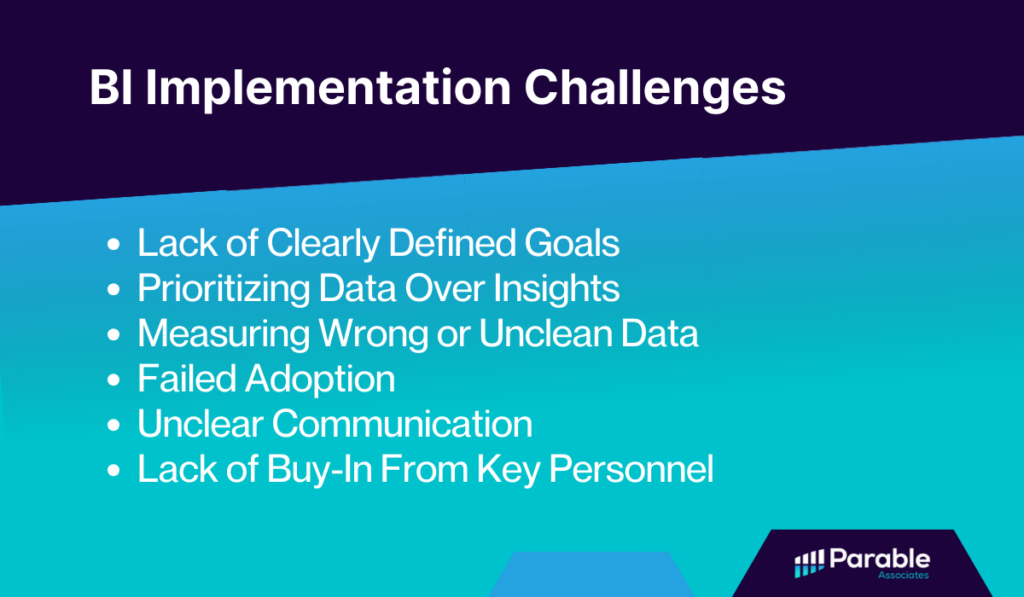The amount of data healthcare practices have to deal with is overwhelming, ranging from patient health records to operational and financial metrics. To navigate the onslaught of information, many practices are implementing business intelligence (BI) solutions. BI promises to transform raw data into meaningful insights that can guide decision-making and streamline operations. However, unlocking the full potential of BI requires a strategic approach to implementation. Without it, practices risk not extracting the valuable insights they need, ultimately failing to make the most of their investment. Understanding the common challenges of business intelligence implementation and how to bypass them, ensures healthcare practices can fully leverage the power of BI tools.
Common Challenges
As healthcare practices increasingly turn to BI solutions to navigate the complexities of their data, the implementation of these systems often encounters a set of common challenges. Understanding these challenges is the first step towards mitigating them and unlocking the full potential of BI to drive informed decision-making and operational excellence.
Lack of Clearly Defined Goals
What information and insights are you looking to extract from your data? One of the primary hurdles in business intelligence implementation is neglecting to set clearly defined goals. Without specific objectives, it is difficult to determine what data to analyze and what insights you want to extract from that data. This often leads to a misalignment between the capabilities of the BI solution and the practice’s needs.
Solution: Discovery, the first step in BI implementation, is the process of establishing clear, measurable objectives for what the BI tool should achieve. Whether it’s improving patient care, enhancing operational efficiency, or boosting financial performance, having specific goals will guide the implementation process.
Prioritizing Data Over Insights
Another challenge is the tendency to focus more on collecting data than on extracting actionable insights. This can result in reducing the potential impact of BI on enhancing operational and financial efficiency to drive the practice forward. The value of BI is not just its capacity to amass vast quantities of data but in its ability to distill data into coherent, actionable intelligence that can serve as the basis for an informed decision-making process. The true benefit is revealed when BI tools are leveraged to sift through the data, identify patterns, and translate these findings into clear, actionable insights.
Solution: The key to successful business intelligence implementation requires closely involving end-users in the design process. This allows practices to determine what data is necessary to align the BI solution with the specific decision-making needs of those users. This approach maximizes the BI investment, ensuring the technology effectively supports informed decision-making and enhances both operational and operational efficiency.

Measuring Wrong or Unclean Data
The effectiveness of BI insights hinges on data quality. Utilizing incorrect or unclean data, such as inaccurate, incomplete, duplicated, or outdated information, can yield misleading insights, adversely affecting decision-making. The consequences of basing analyses and strategic decisions on such compromised data are far-reaching. It can result in misallocated resources, missed opportunities, and strategic missteps that could hinder a healthcare practice’s efficiency and competitive edge. Moreover, relying on incorrect or unclean data for decision-making can lead to a disconnect between expected outcomes and actual results, eroding trust in the BI system among users and stakeholders.
Solution: To maintain BI insight effectiveness, a comprehensive data management strategy is critical. It should include frequent data accuracy checks, duplication removal, and updating of outdated information. Utilizing data cleansing tools can streamline this, improving both efficiency and data reliability. Additionally, cultivating a data-literate culture ensures every team member values and upholds data quality. Prioritizing these steps ensures BI analyses are founded on clean, accurate data, facilitating better decision-making, resource optimization, and a sustained competitive edge, thereby strengthening trust in BI systems.
Failed Adoption
The effectiveness of a BI solution hinges on user adoption. When the staff does not fully embrace, integrate, and utilize the BI tools made available to them, the potential benefits of the BI solution are severely limited. This lack of adoption could stem from a range of factors, including resistance to change, perceived complexity of the new system, inadequate training, or a disconnect between the tool’s functionality and user needs.
Solution: Overcoming the hurdle of user adoption requires a concerted effort to align the BI tool with user expectations. This includes providing comprehensive training, demonstrating its value in improving outcomes, and possibly modifying the tool’s interface to cultivate a culture that not only accepts but also champions the use of BI in their daily routines.
Unclear Communication
Successful business intelligence implementation is rooted in the clarity of communication between the technical team responsible for deploying the solution and the end-users who will interact with it daily. For instance, without clear, ongoing conversations, a BI system may become overly complex, making it difficult for users to navigate and extract the needed insights effectively. Furthermore, if end-user requirements, preferences, and feedback are not adequately communicated to the implementing team, there’s a risk of developing a solution that is either too simplistic, lacking in functionality, or misses critical features necessary for the decision-making processes.
Solution: Maintain open lines of communication between the implementation team and the end-users. Clear communication is crucial for tailoring the BI solution to the specific needs of end-users. It also ensures that any issues are resolved quickly, empowering practice staff and maximizing the benefits of BI technology.
Lack of Buy-in From Key Personnel
Securing the commitment and support of key personnel is pivotal for successful BI implementation. Without the advocacy of top management, executives, and department leaders, a BI initiative may struggle to secure the required funding, access to data, and integration with existing systems and workflows, which are essential for a seamless implementation process. Resistance from these crucial stakeholders can also have a cascading effect on the team, creating skepticism or reluctance to embrace the new BI solution. Such a scenario can significantly impede the project’s momentum, leading to delays, reduced functionality, or in the worst cases, complete project abandonment.
Solution: To overcome the challenge of securing buy-in for a BI project, it’s vital to engage top management and key staff early, showcasing the solution’s benefits and its alignment with the practice’s goals. Demonstrating tangible improvements through case studies, addressing specific operational and strategic needs, and offering hands-on training can illustrate BI’s value. This strategy not only garners support but also positions the BI system as a strategic asset, essential for the practice’s success and operational efficiency, facilitating a smoother adoption process.

Parable Associates: Your Partner in Business Intelligence Implementation
Implementing a BI solution in healthcare practice comes with its own unique set of challenges. However, with the right approach, these hurdles can be overcome, allowing practices to fully harness the power of BI. Parable Associates follows an industry-proven six-step method to ensure proper BI implementation. We specialize in streamlining the process for healthcare practices.
At Parable Associates, we understand the nuances of healthcare data and the specific needs of healthcare practices. Our comprehensive approach ensures that your BI implementation is aligned with your practice’s goals, from the initial planning phase to user training and support. If you are currently working with ModMed, Experity, or WebPT, but find that they don’t always provide the level of detail needed for in-depth analysis and strategic planning, we can help. Our expertise lies in building custom BI dashboards that access the correct data, provide actionable insights, and are user-friendly, ensuring widespread buy-in. Let us handle the complexities of BI implementation, so you can focus on what you do best. Schedule a Discovery Call today and unlock the full potential of your practice.
BI Implementation FAQs
Implementing BI solutions in healthcare practices often encounters challenges such as lack of clearly defined goals, prioritizing data collection over insights, low user adoption rates, unclear communication between implementers and end-users, lack of buy-in from key personnel, dealing with incorrect or unclean data, and choosing BI tools that users find difficult to use.
Clearly defined goals are crucial because they guide the entire BI implementation process, helping to determine what data is needed and what insights to extract. Without specific objectives, practices risk misaligning the BI solution with their needs, making it difficult to achieve meaningful outcomes.Lorem ipsum dolor sit amet, consectetur adipiscing elit, sed do eiusmod tempor incididunt ut labore et dolore magna aliqua. Ut enim ad minim veniam, quis nostrud exercitation ullamco laboris nisi ut aliquip ex ea commodo consequat.
Focusing primarily on data collection rather than actionable insights can diminish the impact of BI, leading to vast amounts of data with little practical use. Successful BI implementation relies on translating data into intelligence that informs decision-making and operational improvements.
Failed adoption can stem from several factors, including resistance to change, perceived complexity of the new system, inadequate training, or a disconnect between the tool’s functionality and the users’ needs. Overcoming these requires aligning the BI tool with user expectations and providing comprehensive training.
Clear communication between the technical team and end-users ensures the BI solution meets user needs and any issues are promptly addressed. This fosters a more empowering environment for practice staff and maximizes the benefits of BI technology.
Without support from top management and key staff, BI projects may struggle to secure necessary resources and integration, leading to project delays or abandonment. Early engagement and showcasing the BI solution’s benefits are vital for securing buy-in.
Parable Associates specializes in streamlining BI implementation for healthcare practices, ensuring the process aligns with the practice’s goals from planning to user training. We build custom BI dashboards that provide actionable insights and are user-friendly, promoting widespread buy-in and maximizing the return on investment in BI technology.

